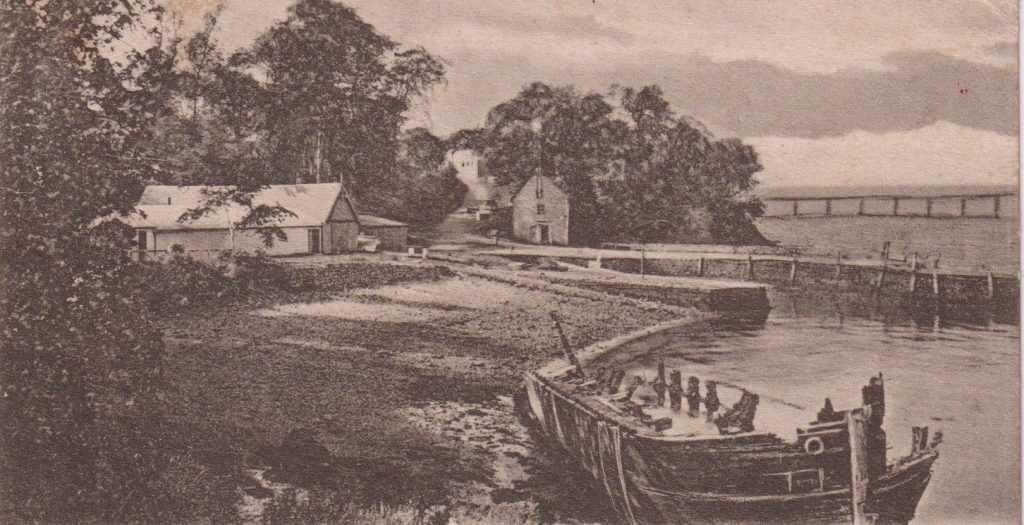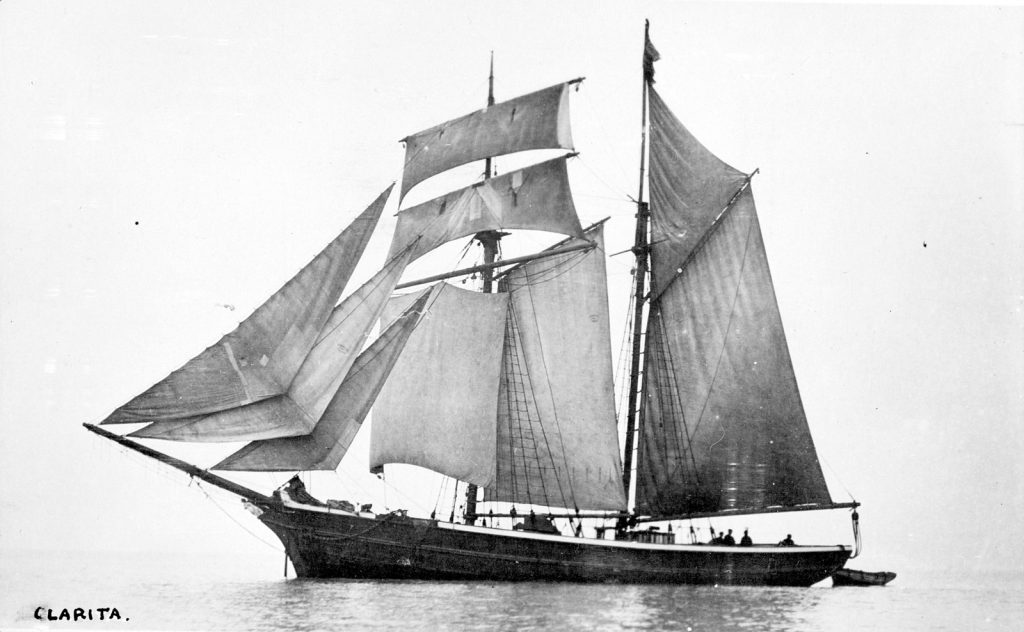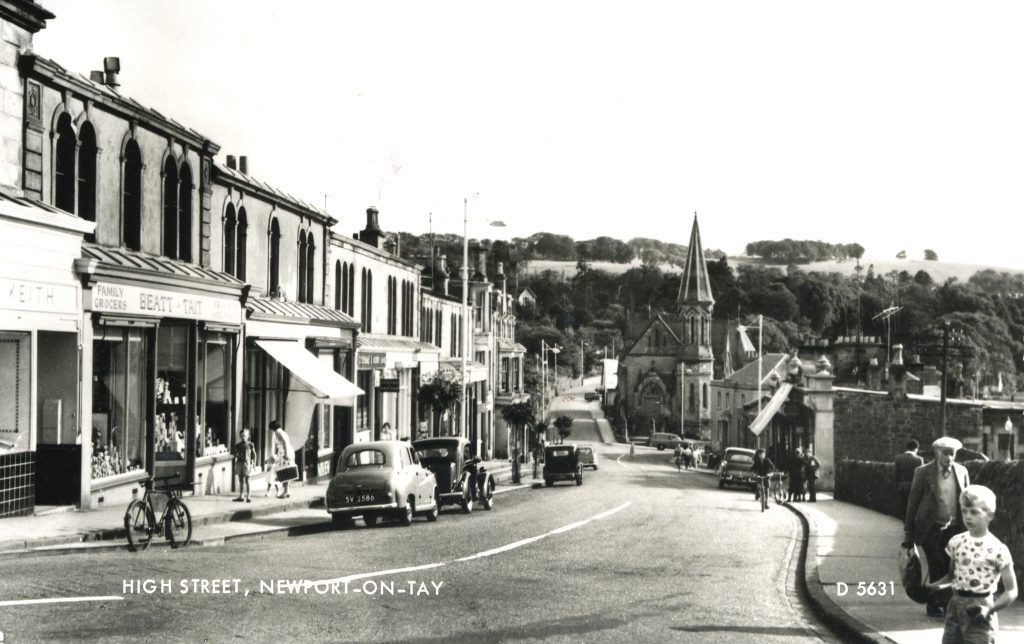Woodhaven Pier has over the years been the site for many activities, all ideally suited to the sheltered spot:
- Wormit Boating Club – a thriving water sports club
- workshop areas for a joiner and a car mechanic
- the base for the local Scout troop
- the base of Squadron 333 of the Royal Norwegian Air Force operating Catalina flying boats
- the shore base for the Mars training ship (the pier is still called the Mars Pier by locals)
- a harbour for coastal trading vessels
- a shipbuilding yard
- workshop areas for a builder and contractor
- a terminal for the ferry to Dundee, and the main road south to Cupar and beyond.
Of all of these, it is the shipbuilding that is least well known.
Joseph Garland leased a piece of ground here in 1847. The site is now the Wormit Boating Club dinghy park. The Fifeshire Journal described the site as being ‘exceedingly well chosen and offers many advantages over shipbuilding yards in Dundee, from the greater depth of water on the south side of the river, and the comparatively trifling rents at which the ground can be secured’. The report went on to predict the building of new housing for the incoming workforce.1
Garland had been in partnership with James Horsburgh in the firm of Garland & Horsburgh, shipbuilders, Dundee (trading initially as the Dundee New Shipbuilding Co.) from 1831 to 1837. Altogether they built 18 ships. When that company was wound up, Garland went to Newburgh where he operated a very successful shipbuilding company from 1837 to 1846, constructing another 18 ship
Then he moved here.
He built 6 ships here from 1847 to 1853; apart from the Hope they were coasting & North Sea vessels.3 The first 3 were either commissioned from him or were sold immediately upon completion. The latter 3 he operated himself for a time before selling them on.
The ships were wooden sailing vessels and were constructed when steam engines were rapidly gaining favour and iron hulls were beginning to be used. They were constructed in a depression in the ground, the hull being supported on legs. At the launch, the depression was flooded and the ship floated out. But changes in technology meant that this method of construction was by now outdated and larger premises with bigger slipways were required.

The following information4 about the ships built here was researched 30 years ago and required a trip to London. Since then, much more has become available on the internet. I leave it to you to explore further.
Catherine Spence

- Registered Sep 1848, 74 tons, 2-masted schooner, length 60.8′, beam 17.2′, hold depth 9.2′
- First owner, from 1848, was David Spence, wood merchant of Tayport. He sold her in 1852 to Alexander Russell of Myrecairnie.
- From May – September 1850 she is known to have been coasting. She was crewed by her Master, Captain David Rollo, and 3 men.
- She was reported missing in 1854 bound from Tayport to London with potatoes.
Lee
- Registered Jun 1849, 103 tons, 2-masted schooner, length 69.7′, beam 18.1′, hold depth 10.1′
- First owner in 1849 was James Cooper of Arbroath. She was sold in 1853 to David Stewart of Dundee. Sold again in 1857 to David Low, coal merchant of Ferryden. She operated from Montrose and was later sold to William Alexander who had been her Master for several years. At this change of ownership, William Alexander had 60 shares and John Balfour Alexander, described only as shipowner, had 4 shares.
- She was a coasting vessel and was finally wrecked at Rosehearty in September 1868, her Master being William Alexander.
Hope

- Registered Mar 1850, 203 tons, 2-masted snow, length 83.9′, beam 20.9′, hold depth 14.3′
- First owners: William Mudie Paton & Robert Fleming, merchants, Dundee (32 shares each).
- Her first voyage was Dundee – Riga – Montrose, with David Smith, Master, 7 men and 2 apprentices.
- Sold in 1853 to John Wood, shipowner, and Edward Cole, linen merchant, both of Bristol; and registered in Bristol. She made many voyages to West Africa & the Canaries. By 1871 she was coasting.
- Sold to foreigners in 1872.
Petrel
- Registered Apr 1850, 45 tons, 1-masted smack, length 55.9′, beam 15.1′, hold depth 7′
- Garland owned this small ship himself for 6 years, during which time she coasted round the UK with a crew of 3.
- Sold to John Aitken of Stirling, then sold to the Shetland North Sea Fishery Company. They sold her to Francis & Duncan McNeil, mariners of Glasgow, with Francis McNeil as her Master. She was eventually broken up in 1890.
- She was recorded as having left Woodhaven on 10 July 1851, discharged ballast at Newcastle, loaded full of coals and was back again at Woodhaven in 68 hours.5
St Fort
- Registered Feb 1851, 95 tons, 2-masted schooner, length 39.4′, beam 17.7′, hold depth 10.3′
- This ship was also first owned by Garland for a year. Her Master was William Jack, born in Flisk, and there were 4 other crew.
- She sailed from Dundee on 8th February 1851 and is known to have called at Liverpool, Belfast, Bordeaux, Dublin & Pettycur by 14th June.
- Sold to William (10 shares), John (27) & James (27) Wishart, merchants of Leith. They operated her with Peter Johnstone as Master, from Leith to Holland, Spain and the Baltic.
- She was wrecked on the Swedish coast in December 1858.
Seagull
- Registered Aug 1853, 18 tons, 1-masted sloop, length 36.4′, beam 11.3′, hold depth 7′
- Garland owned this last small vessel for 2 years as a coaster. She was then sold to Lerwick and passed through several hands and several Masters.
- She disappears from the shipping lists between 1901 and 1904.
After Garland retired from work here, he continued as a shipowner and operator, and eventually became a Director of the D P & L Shipping Company.6
Two things I did not know at the time but which have emerged in a trawl of old newspapers:
In April 1849 there was an accident at the shipyard and Alexander Rae, a carpenter from Dundee, and another man fell when the stage they were working on gave way. Rae broke his leg in 2 places.7
Another boatbuilder, Peter Watson, started business on the site in January 1855. He built much smaller boats, up to 20′ in length, suitable as ships’ boats or for shooting or fishing. He moved away in June 1856.8
Sources:
- Fifeshire Journal, 8 Jul 1847
- Shipping Notes, J P Ingram, Dundee Central Library
- Shipping Notes, J P Ingram, Dundee Central Library
- Ships’ Muster Rolls, Dundee; Board of Trade: Ships’ Registries: Transcripts & Transactions; Merchant Navy List (various years); Lloyds Register of Shipping (various years); Shipping Notes, J P Ingram, Dundee Central Library
- Dundee Advertiser, 18 Jul 1851, p3
- D P & L Directors Minute Book, Dundee City Archives, GD/DPL
- Dundee Advertiser, 27 Apr 1849 p2
- Dundee Advertiser, 5 Jan 1855, p2; 7 Aug 1855, p1; 10 Jun 1856, p2
Photos: These are as close as I can get to the size of the vessels and the location at the time. They are intended to give a flavour of the topic. Woodhaven Pier – postcard; Clarita from State Library Victoria; Francis Mollison from Newport History Group

